Spratlys’s future and mining’s dark present
Spratlys’s future and mining’s dark present
TORONTO – The contested Spratlys with its reported rich deposits of oil and gas reserves underneath the sea. The raging question of who exactly owns it. The hysteria brought about by an imagined invasion by a mighty state, implying the intervention of another. The claim that acquiring Spratlys, with its rich natural resources, could alleviate Philippine poverty. These are the issues that have made such a hot topic out of the Spratlys, now resurrected all of a sudden, 40 years after the Spratlys became a top news item in the Philippines.
As a result, in Toronto, following a call from a the U.S.-base group of Filpinos, people are already taking action on these issues, as when Filipinos recently picketed the Toronto Chinese Consulate and organized prayer rallies in churches.
Meanwhile, the Community Alliance for Social Justice (CASJ), in collaboration with the Philippine Press Club-Ontario, and Kamalayan, sponsored a forum to discuss the Spratlys in relation to the Philippine extractive industries and sovereignty. Titled, “China vs. the Philippines: The Spratlys Issue and Philippine Natural Wealth” the forum was held at an OISE classroom last August 19. It was attended by almost 60 people that included students, representatives of various organizations, the Consul General of Toronto Pedro Chan, and former Consul General Clemencio Montesa.
Organizers believed the Spratlys topic could only be best understood and appreciated in learning where the Philippines currently stands in its fight for what it claims as its own, amidst the claims of the five other countries. The organizers also believed the Spratlys issue was relevant as it relates to the natural resources of gas and oil it reportedly holds.
Would those resources go the same way current natural wealth in the Philippines – such as forests and minerals — are extracted and exploited? How would the Philippine claim lead to the advancement of national sovereignty, economic gains, and the alleviation of people’s poverty? These were some of the questions that the forum aimed to discuss.
The forum featured three knowledgeable speakers: Joe Rivera, who completed his LLB from Osgoode Law School, a bloggeer and social commentator, who spoke on the background of the Spratlys conflict and its legal aspects; Bern Jagunos, Asia-Pacific Regional Coordinator, United Church of Canada, and human rights advocate on mining and globalization, who talked about foreign interests in extractive industries and Philippine natural wealth; and Alex Felipe, coordinator of Kamalayan, who did a slide presentation on mining in the Philippines.
Joe Rivera:
Following is a summary of Rivera’s presentation:
Spratlys is a collection of small desolate islands mostly submerged underwater during high tide. Prior to the oil exploration in the 70s that revealed that it had oil and natural gas deposits underneath, it was considered a navigation hazard. However, it is located strategically in the South China Sea, along an important vessel route.
Six countries – China, Taiwan, Vietnam, the Philippines, Malaysia and Brunei – all claim to have legal and historical rights to the islands. Such conflicting claims have until now remained unresolved by international law.
The Philippines claims most of the Spratlys Islands belongs to no one at this point. It has particular claim, however, to Kalayaan Island Group (KIG), which as early as 1976 was declared by then President Ferdinand Marcos as a territory of the Philippines, as it is part of the Philippine archipelago.
Rivera’s conclusion: All claims by the six countries remain weak. His proposed solution: diplomacy. The Philippines could pressure the ASEAN to hold talks among the competing states. The states could then agree to exploration and exploitation of natural resources, and allocating the benefits accordingly and appropriately.
Rivera however cited the Malampalaya project in Palawan as a negative example of what an allocation arrangement should be. He said Malampalaya is unsconstitutional in terms of allocation of benefits of natural resources exploitation. The Philippine Constitution allows only 40 percent of benefits going to foreign interests, but in this case, 45% goes to foreign owned Shell Corporation, 45 percent to foreign owned TEXACO, and only 10 percent goes to Philippine National Oil Corporation.
Commenting on the U.S. Pinoys for Good Governance position on the Spratlys issue, Rivera said the group is against what it perceives as “China’s bullying” in the South China Sea. Thus the call for a prayer for peace, implying that there would be a military conflict in that region, which Rivera said he does not believe would happen. It “may be motivated by their desire to make the United States be involved in the South China Sea,” because Australia, New Zealand, Korea and Japan have pressured the U.S. to enter the fray in order to counterbalance China’s presence in the area, he explained.
Bern Jagunos:
The Philippine Mining Act was a bill introduced in the Senate by then Senator Gloria Macapagal Arroyo and signed into law under President Ramos, the main purpose of which is to attract foreign mining corporations to invest in the Philippines.
Provisions in the act favor the interests of foreign corporations, such as 100 percent ownership of mining mineral lands (concessions). This provision specifically contravenes the provisions of the 1987 Philippine Constitution which restricts ownership of foreign entities to 40 percent, Jagunos noted.
Other provisions favorable to foreign corporation are 100 percent repatriation of profits; 100 percent return of equipment; tax incentives; deferred payments; removal of all obstacles to its operations, such as settled communities, farming and livelihood activities; and allowing to sell gold in the international market without intervention from the Central Bank.
As a result of such enticements, there has been an influx of mining corporations and an exponential increase in mining activities. In 1995, there were 262 mining production sites; in 2010 there were 702 productions sites and more than 2,100 mining applications.
In some provinces, majority of the land areas are covered by mining activities, such as the Zamboanga region, the Cordilleras, Surigao and Agusan. In one town, 70 of its 75 baranggays were mining areas. These areas area not empty lands but inhabited places.
A major concern is foreign interference. The World Bank has been aggressively promoting further liberalizing of mining industries, resulting in administrative and executive orders that liberalized the mining industry, giving them broader powers than the Mining Act.
In 2004, the Supreme Court ruled that the Philippine Mining Act was unconstitutional but 10 months after, the SC reversed its decision because of pressure from the executive and legislative branches of government.
Another concern is loss of national sovereignty over land and natural resources as well as the negative impact on the people, Jagunos noted. While mining companies in 2007 had a gross production of P101 billion, the collection of the Philippine government was only P5 million. Hence mining is not at all an engine for economic growth in the country, as officially claimed. The mining industry has a low ability for job creation. It leads to environmental costs such as mine tailings dumped into the sea, resulting in the loss of livelihood of people, health hazards to community due to toxic wastes, lack of proper clean-up, and inappropriate compensation to the victims, if any. Also it has led to militarization of communities and repression of those who oppose the mines. It has further led to the perpetration of human rights violations and extrajudicial killings of activists, such as what has happened in Mindoro, Jagunos said. It has also dislocated communities, including indigenous populations.
Alex Felipe:
Why Spratlys and mining? The issue is about extractive industries, in this case, oil and gas. It is also an issue of patrimony, of sovereignty. Will future extraction of oil and gas alleviate poverty? Based on his recent visits to mining communities in the Philippines, which he recorded through interviews and photographs, Felipe talks about the toll the mining industry has taken on the environment and on human lives.
In his presentation titled “Snow from Canada” Felipe told a story of how the Canadian company Placer Dome and the then Marcos-owned Marcopper had left a legacy of destruction and despair in a community in Marinduque where they had operated a mine. For 15 years, 24 hours a day, toxic mine tailings were dumped into the sea resulting in 15 kilometers of artificial land jutting out of its coast. During the hot season, the dried-up tailings were picked up by the wind and swept up to the sky, then dropped into the village as silvery white flakes, much like fallen snow, thus the title of his presentation.
In 1996, environmental and human disasters occurred when mine tailing accidents happened: tailing pipes broke, spilling the toxic wastes into two major rivers – Boac and Mogpog, resulting in the death of two children. The parents were compensated a mere $22 each. In 1998, the Philippine government tested 59 children and it was found out they suffered from heavy metal poisoning thru toxins seeping into their skin, thru the water they drank, and the air they breathed.
As kids still play on toxic soil, people fish and sell catch to community members – as they are unable to sell outside, people’s health continues to be compromised. Many children had birth defects, suffering from either mental difficulties, swollen limbs, wounds that never healed, leading to amputations. As for poverty alleviation, people in the community are poor, and Marinduque is one of the top ten poorest provinces in the Philippines.
Rapu-Rapu is another community in Philippines where mining is operated by an Australian-owned firm. In 2005, there was a spill of toxic tailings, followed in 2007 by a chemical spill. As a result, a month after the spill, people could still not fish, so they had to depend on food from the church. The mine area looked too deserted to be considered a place where people could get jobs, contrary to claims of employment being generated by the project.
In Zamboanga, where Toronto Ventures Inc operates, 10,000 people were working there when the mine was still owned by the local people. When the Canadian company came, only 800 people worked there.
After the three speakers were done with their talks, several people participated in the question and answer discussion. Most comments reaffirmed the tie-up between the Spratlys and the state of the Philippine extractive industries, specifically mining. Some in the audience came to conclusion that the mining act should be changed to remove the provisions that benefit only foreign mining interests and are detrimental to the interests of the Philippines and its people.
(For more analysis and information on the question of the Spratlys, go to Rivera’s blog: http://anuncomplicatedmind.blogspot.com For the full video of the forum, go to: http://www.veoh.com/watch/v21218262perNe84B)
(Special thanks to io media/halo halo 10 for the use of its video in writing this story.)



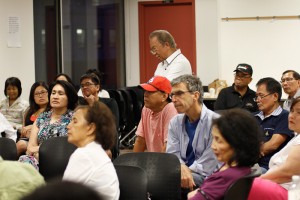
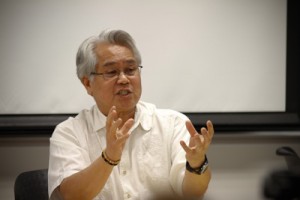
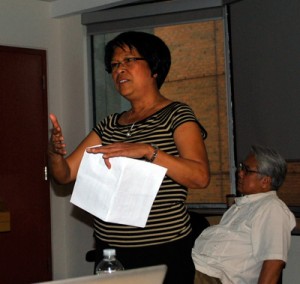
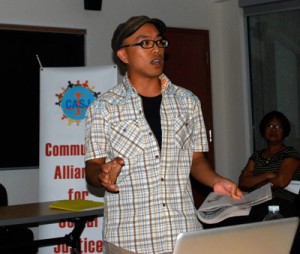
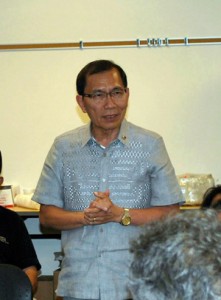
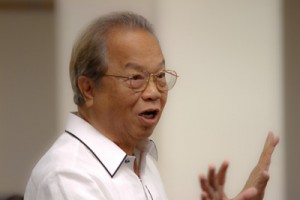
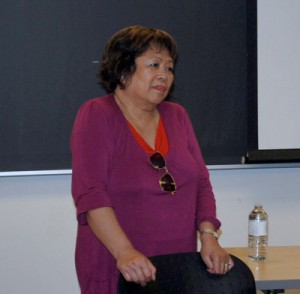
Comments (0)